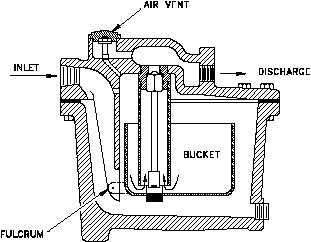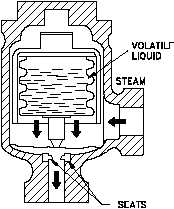STEAM TRAPS
DOE-HDBK-1018/2-93
Miscellaneous Mechanical Components
Bucket Steam Trap
Figure 17 Bucket Steam Trap
A bucket steam trap is illustrated in
Figure 17. As condensate enters the trap
body, the bucket floats. The valve is
connected to the bucket in such a way that
the valve closes as the bucket rises. As
condensate continues to flow into the trap
body, the valve remains closed until the
bucket is full. When the bucket is full, it
sinks and thus opens the valve.
The
valve
remains
open
until
enough
condensate has passed out to allow the
bucket to float, and closing the valve.
Thermostatic Steam Traps
There are several kinds of thermostatic steam traps in use. In general, these traps are more
compact and have fewer moving parts than most mechanical steam traps.
Bellows-Type Steam Trap
A bellows-type steam trap is illustrated in Figure 18. The operation of this trap is controlled by
the expansion of the vapor of a volatile liquid, which is enclosed in a bellows-type element.
Steam enters the trap body and heats the volatile liquid in the sealed bellows, causing expansion
of the bellows.
Figure 18 Bellows-Type Steam Trap
ME-05
Rev. 0
Page 36





